Toastmaster THE CORNER BAKERY Cookbook

R888_Cookbook_4-4-03 4/4/03 8:08 PM Page 1
The CornerBakery ®
Bread & Dessert Maker
Cookbook
61218

R888_Cookbook_4-4-03 4/4/03 8:08 PM Page 2
Table of Contents
Welcome to Bread Making . . . . . . . . . . . . . . . . .3
Helpful Hints For Bread And Dough. . . . . . . .4
Bread Introduction . . . . . . . . . . . . . . . . . . . . . . .9
Bread Recipes . . . . . . . . . . . . . . . . . . . . . . . . .10
Day Old Bread Uses . . . . . . . . . . . . . . . . . . . .19
Fast Bake™ Breads . . . . . . . . . . . . . . . . . . . . . .20
Dough Introduction . . . . . . . . . . . . . . . . . . . . .24
Helpful Hints for Dough . . . . . . . . . . . . . . . .25
Dough Recipes . . . . . . . . . . . . . . . . . . . . . . . .26
Butter Introduction . . . . . . . . . . . . . . . . . . . . . .36
Helpful Hints for Butter . . . . . . . . . . . . . . . .37
Butter Recipes . . . . . . . . . . . . . . . . . . . . . . . .38
Desserts Introduction . . . . . . . . . . . . . . . . . . . .42
Helpful Hints for All Desserts . . . . . . . . . . . .43
High Altitude Adjustments . . . . . . . . . . . . . 46
Cake Introduction . . . . . . . . . . . . . . . . . . . . . .47
2.
Helpful Hints for Cakes . . . . . . . . . . . . . . . . .48 Cake Recipes . . . . . . . . . . . . . . . . . . . . . . . . .49
Cheesecake Introduction . . . . . . . . . . . . . . . . .55
Helpful Hints for Cheesecakes . . . . . . . . . . .56
Cheesecake Recipes . . . . . . . . . . . . . . . . . . . .58
Pudding, Pie Filling & Fudge
Introduction . . . . . . . . . . . . . . . . . . . . . . . . . . .60 Helpful Hints for Puddings/
Pie Fillings . . . . . . . . . . . . . . . . . . . . . . . . . . .61 Pudding/Pie Filling Recipes . . . . . . . . . . . . . .62 Helpful Hints for Fudge . . . . . . . . . . . . . . . . .65 Fudge Recipes . . . . . . . . . . . . . . . . . . . . . . . .66
Recipe Index . . . . . . . . . . . . . . . . . . . . . . . . . . .70
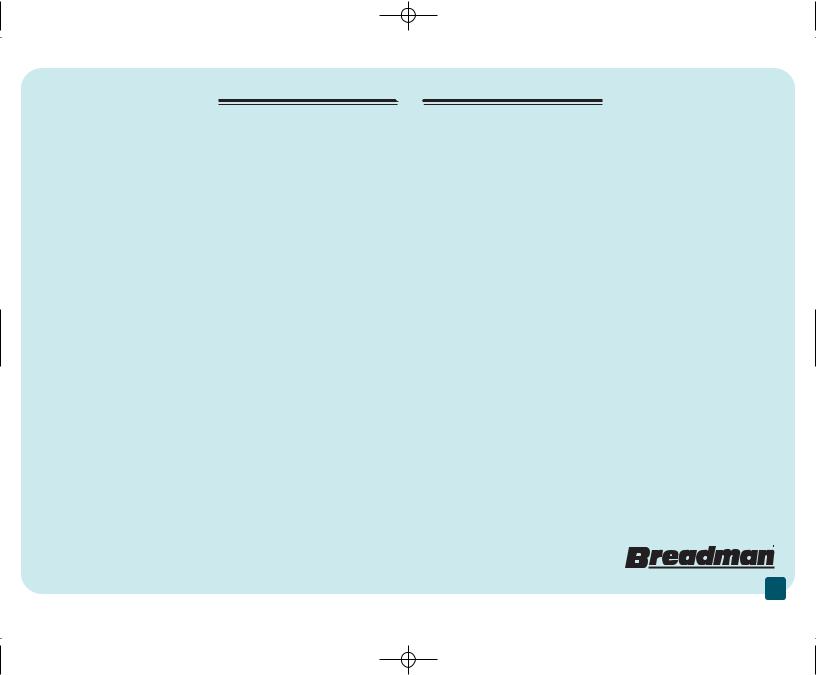
R888_Cookbook_4-4-03 4/4/03 8:09 PM Page 3
Dear Breadman™ Customer:
Welcome to the Breadman™ family of happy bread bakers! We’re sure you’ll find machine bread making to be a rewarding and tasty experience.
Please be sure to take a few minutes to read the Use and Care Guide carefully and completely. While bread machines take a lot of the work out of making homemade bread, they do require a bit of effort to achieve the best results. Make sure you are following the directions closely to ensure success every time and pay particular attention to the section called “Helpful Hints for Bread & Dough.” If you follow the guidance offered in these pages, you can avoid many of the most common difficulties. To assist you even more, our home economists, with help from their colleagues at Red Star® Yeast & Products, have spent many hours in our test kitchens developing bread and dough recipes and suggestions for correcting common problems that may occur from time to time. Please refer to the Checklist near the very back of the Use and Care Guide for this troubleshooting information.
Most people find that once they have become accustomed to the process of machine bread making, they can turn out wonderful loaves in everincreasing numbers — and they also find that their friends and family will be happy to take any extras off their hands!
Breadman™ welcomes your comments and discoveries! Please write to us c/o The Test Kitchen, Breadman™ Inc., 1801 North Stadium Boulevard, Columbia, Missouri 65202.
Thank you for deciding to join the Breadman™ family. We look forward to being a part of your bread making for many years to come. Happy baking!
Sincerely,
Marilyn Wise
Manager Consumer Education & Product Testing
3.

R888_Cookbook_4-4-03 4/4/03 8:09 PM Page 4
Helpful Hints For Bread And Dough
It is recommended that you read the following information before you shop for your ingredients. Your machine will bake up to a 2 pound loaf of fresh bread containing approximately 4 cups of flour. All ingredients except liquids must be at room temperature and liquids should be approximately 80°F/27°C (baby bottle temperature) unless otherwise noted. Always place the ingredients in the bread pan in the order listed in the recipe: liquids, dry ingredients and then yeast. Some ingredient amounts are the same for different size loaves, this is correct.
Measuring The Correct Way
Be sure to measure accurately for success. Even slight measuring inaccuracies can make a big difference in your results. Measure each ingredient precisely before placing it into the bread pan.
When you are measuring liquids, use a clear glass or plastic liquid measuring cup. To ensure accuracy, set the measuring cup on the counter top and read the measurement at eye level.
To measure your flour, spoon it lightly into a standard dry ingredient measuring cup and level it with a straight edge. Also, do not shake the cup or tap it on the counter top. Do not scoop the flour with the measuring cup as this tends to pack more flour than the recipes call for.
Use standard measuring spoons and level with a straight edge of a knife.
Measurement Conversion Chart
12 tsp = 2 TBL
3 tsp = 1 TBL
2 TBL = 12 tsp
2 TBL =8 cup
4 TBL = 4 cup
5 TBL + 1 tsp = 3 cup
8 TBL =2 cup
12 TBL =p cup
16 TBL = 1 cup
a cup = 4 cup + 2 TBL b cup =2 cup + 2 TBL c cup = p cup + 2 TBL
Dough Ball: Necessary For A Successful
Loaf Of Bread
Liquid amounts called for in a recipe may need to be adjusted slightly because different climates and seasons result in a wide variety of humidity levels. You may want to check the dough ball half way through the first kneading cycle. At this point, the ball should be round, smooth-textured, soft and slightly tacky to the touch.
If it does not form a ball and is more like a batter, add 1 tablespoon of flour at a time until it
4.
reaches the appropriate consistency. On the other hand, if the mixture is too dry to form a ball or forms more than one ball, add 1 teaspoon of water and allow it to absorb. Add more water if necessary.
Provided you have used all of the ingredients specified in the recipe, measured the ingredients properly and have a “good” dough ball, you should achieve a successful loaf of bread. If the dough ball is dry, it may cause the bread machine to fall off the counter top. Any damage to your bread machine as a result of falling from the counter will not be covered under warranty.
Yeast: The Number One Ingredient
Red Star Active Dry Yeast was used in the development of all the bread recipes listed in this cookbook. However, Red Star Quick•Rise™ Yeast may also be used. Amounts used do not need to be varied when substituting one for the other. When using bread machine yeast, follow the package instructions.
A 4-oz package of Red Star Yeast contains approximately 24 level teaspoons of yeast. When the yeast is exposed to oxygen, moisture or warmth, the activity of it deteriorates. Therefore, it is recommended to store yeast in an airtight container, refrigerating or freezing it. Measure out the amount you need and
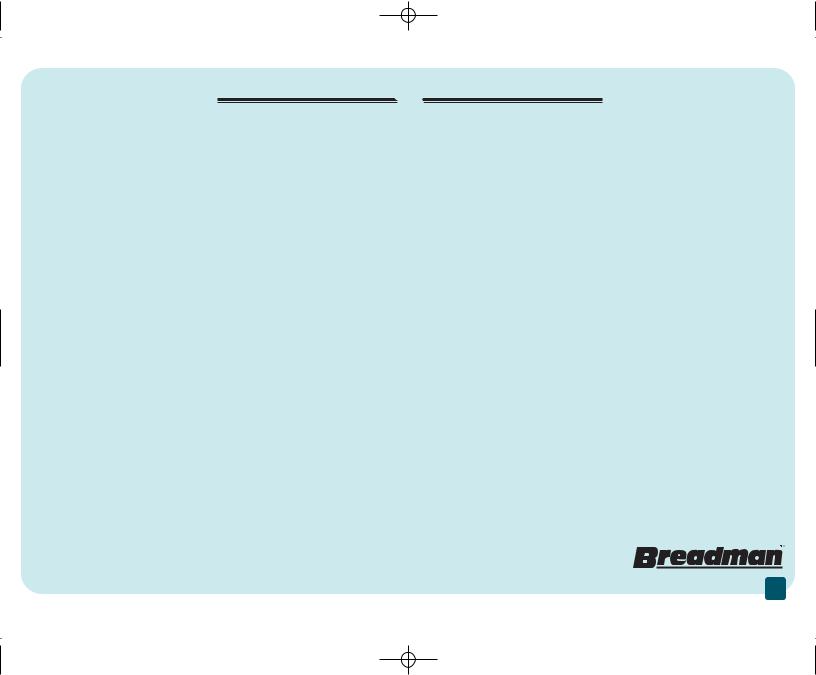
R888_Cookbook_4-4-03 4/4/03 8:09 PM Page 5
allow it to come to room temperature before using it — this takes about 15 minutes.
If you have any doubt regarding the activity of the yeast, you may use one of the following tests to determine its strength. Each test calls for a different amount of yeast as a base ingredient. This gives you more bread choices once the test is complete.
To test for one package 4(2 teaspoons) of Red Star Active Dry or Quick Rise™ Yeast, use a liquid measuring cup and fill it to 2the cup level with 110°F/27°C - 115°F/46°C water. Stir in 1 teaspoon granulated sugar and 1 package (24 teaspoons) Red Star Active Dry or Quick•Rise™ Yeast. Leave your stirring spoon in the cup. Set a timer for 10 minutes. As the yeast absorbs liquid, it will begin to activate and rise to the surface. If at the end of the 10 minutes the yeast has multiplied to the 1 cup mark, it is very active.
The yeast mixture may be used in your Breadman™ Corner Bakery and Dessert Maker in a recipe that calls for 24 teaspoons of yeast. Remember to adjust your recipe for the 2 cup of water and 24 teaspoons of yeast used in the test. The sugar does not need to be adjusted.
To test for 12 teaspoons of Red Star Active Dry or Quick•Rise™ Yeast, use a liquid mea-
suring cup and fill it to the4 cup level with 110°F/27°C - 115°F/46°C water. Stir in 1 teaspoon granulated sugar and 12 teaspoons Red Star Active Dry or Quick•Rise™ Yeast. Leave your stirring spoon in the cup. Set a timer for 10 minutes. As the yeast absorbs liquid, it will begin to activate and rise to the surface. If at the end of 10 minutes the yeast has multiplied to the2 cup mark, it is very active. The yeast mixture may be used in yourBeadman™ Corner Bakery and Dessert Maker in a recipe
that calls for 12 teaspoons of yeast. Remember to adust your recipe for the4 cup of water and 12 teaspoons of yeast used in the test. The sugar does not need to be adjusted.
Flour: Bread Flour Is Essential For
Bread Recipes
All types of flour are affected by many factors, such as milling grades, moisture content, length of storage and manufacturing processes. Adjustments to the recipes may need to be made to compensate for climate changes in different regions to ensure an excellent loaf.
Bread flour is a definite necessity. Milled from hard winter or spring wheat, it has a higher protein content that makes it more durable than all-purpose flour. The protein, when mixed with liquid, becomes gluten. When
kneaded, gluten becomes elastic and gives the bread better structure. In contrast, all-purpose flour, milled from a combination of soft and hard wheat, becomes elastic too easily for use in a bread machine and quickly loses the ability to stretch well.
As a result, bread made from all-purpose flour will be small and dense. Several well-known mills now market bread flour. It is labeled bread flour on the package and is available at grocery stores.
Wheat is the only grain that contains the type of protein that becomes elastic when kneaded. Other flours, such as rye, barley, oats, soy, rice and buckwheat, add flavor and fiber to breads but do not add structure to the dough. Therefore, wheat flour is essential as a base when making bread.
Vital wheat gluten is produced by processing white flour one more step. White flour contains both protein and starch, and mills now can remove most of the starch leaving only the protein (gluten). When gluten is added to recipes containing whole grain flours, it
5.

R888_Cookbook_4-4-03 4/4/03 8:09 PM Page 6
improves the volume and shape of the loaf significantly. Many grocery stores stock gluten in the flour section. Health food and nutrition centers also carry this item.
Flour is best kept in an airtight container. If you are storing the flour for a long period of time, you may want to keep it in the freezer, as the refrigerator tends to dry it out. Whole grain wheat flours, which have a higher oil content, will become rancid much more quickly than white flour and should always be kept in the freezer. Be sure, however, to allow all flours to return to room temperature before placing in the machine.
Fat: Dough Enhancer And Conditioner
Recipes in this cookbook call for vegetable oil. You may substitute in equal proportions solid shortening, real butter or margarine. Divide them into small pieces before placing in the bread pan. There is no noticeable difference in flavor but the crust may be crispier with real butter. Margarine tends to make the crust a little tougher. Light and whipped margarines do not work well.
Liquids: Activate The Yeast And Bind The
Dough
In this cookbook, the term liquid refers to all wet ingredients used in the recipe. When yeast is used in a bread machine, it is very important that the liquid temperature is 80°F/27°C. With this temperature, the yeast activates gradually to accommodate the program of the machine. When higher temperatures are used, the yeast activates too quickly and the dough becomes too warm.
Eggs are also considered part of the total liquid amount. Eggs should be at room temperature. When you remove them from the refrigerator, place egg in shell in a bowl of warm water.
After warming egg to room temperature, place egg in measuring cup and add enough liquid 80°F/27°C to equal whatever total measurement the recipe calls for. For example:
Yield |
1 pound |
egg, room temp. + enough |
1 |
water 80°F/27°C to = |
p cup |
Place the eggs (room temperature) in a liquid measuring cup. Slowly add warm liquid (80°F/27°C) to measuring cup until you have reached the total amount called for in the recipe.
Cinnamon and Garlic: Not True Friends Of
Yeast
In the past, cinnamon and sugar were sprinkled on dough before it was rolled up jelly-roll fashion.
Adding it to the dough in a bread machine, however, presents a problem. Cinnamon reacts with bread dough just as a meat tenderizer reacts with meat. It breaks down the structure. Although it smells wonderful as it is baking, some of the flavor is dissipated in the baking process.Do not add more than what is listed in the recipe.
Garlic inhibits yeast activity. Again, do not add more than the quantity listed in the recipe. For more garlic flavor, use a spread for the bread rather than adding it to the dough.
6.
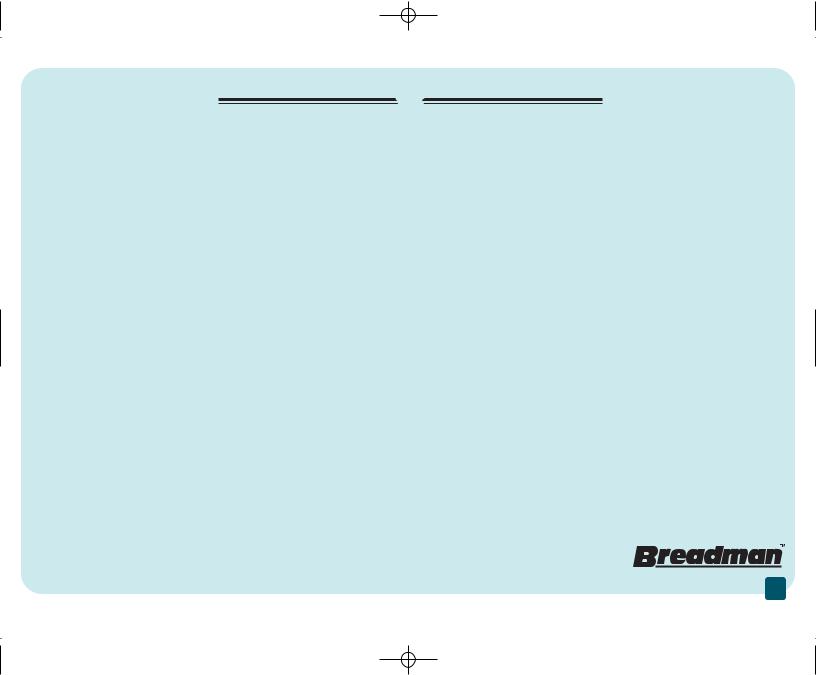
R888_Cookbook_4-4-03 4/4/03 8:09 PM Page 7
Salt: Regulates Yeast Activity
Salt is necessary to control the activity of yeast, disciplining it to work slowly and steadily. Without salt, yeast acts too rapidly. Salt also strengthens the structure of the dough. If too little or no salt is used, the bread will rise rapidly and then fall. The texture may also be course and/or uneven.
Sugar: Food For Yeast
Sugar is the favorite food of yeast, but too much sugar will cause the yeast to overreact. The loaf of bread will be small and dense. Dried fruits also contribute sugar to the bread dough. For best results, do not add any more than is specified in each recipe. In addition, avoid the use of artificial sweeteners because the yeast cannot react with them.
Substitutes
It is common to experiment with ingredient substitution. The following substitutions have been found to be acceptable. However, results may vary significantly. If you would like to try other substitutions, there are several helpful hint books available from retail stores to assist you. However, results are not guaranteed.
Milk: Coffee creamer, non-dairy creamer or dry buttermilk may be substituted for dry milk in
equal proportions. Liquid milk (80°F/27°C) may be substituted for water in equal proportions. The dry milk may then be eliminated altogether. The loaf will be slightly smaller.
Sugar: Honey may be substituted for sugar in equal proportions. Reduce the liquid by the same amount. Brown sugar may be substituted for white sugar in equal proportions. Yeast needs sugar,no artificial sweetener should be used.
Salt: Salt-free recipes are not successful. Dietetically sodium free (less than 5 mg sodium per serving) or low salt (less than 2 the sodium of table salt) may be used in equal amounts. The bread will have a coarser texture.
Eggs: Liquid egg substitutes may be used as directed on the carton. Two egg whites may be substituted for one whole eggRemember,. all egg products must be at room temperature.
Fruits and Vegetables
When adding fruits or vegetables to recipes, do not exceed the amount listed. These products, if used in excessive amounts, may inhibit the rising of the bread.
Using Delay Timer
If you are going to use the delay timer, make sure the yeast is added last, on top of the flour and away from all liquids. This will keep the
yeast from activating until the machine starts to mix. Also, be sure to reduce the amount of water by 1 teaspoon for a 1 pound loaf, 2 teaspoons for a 12 pound loaf and 1 tablespoon for a 2 pound loaf. Do not use eggs or any perishable foods with the Delayed Setting.
Bread Mixes and other Recipe Books
Use mixes labeled for up to 2 pound loaves. For best results, use the Basic or Insta Program. Even though there are a wide variety of recipes for bread and dough offered here, you may be looking for one that is not included in this cookbook. Bread machine helpful hints and recipe books are available at book and retail stores. They offer a wide variety of recipes. Refer to Basic Features in the Use and Care Guide, for the best bread program to use for other recipes. Minor adjustments may be necessary for best results.
High Altitude
High elevations may make the dough rise faster. First, try the recipe as it is printed. If you find the results are unsuccessful, decrease your yeast 4 teaspoon at a time. You may also have to increase the water. Start with 2 tablespoons and increase
7.

R888_Cookbook_4-4-03 4/4/03 8:09 PM Page 8
it if necessary. The addition of gluten will also help the structure of the bread. The recommended amount is 1 teaspoon per cup of flour.
Freezing Baked Breads and Rolls
When freezing breads and rolls, allow them to cool before wrapping in plastic wrap. Place them in a plastic bag and seal it. Bread may be frozen for up to six weeks. When you thaw, partially open the wrapping to allow the moisture to escape gradually for best results.
Freezing Dough
At the end of the dough program, you may remove the dough and freeze it for baking at a
later time. Form the dough into the desired shape and immediately freeze for one hour to harden. Remove from the freezer and wrap in plastic wrap. Next, place it in a plastic bag and seal. Dough can be kept in the freezer for up to four weeks. Thaw the dough in a plastic bag in the refrigerator overnight or for several hours. Unwrap and place on baking container. Cover and let stand in warm, draft free place until double the original size. Because the dough is not room temperature, you will find it takes longer than usual to rise. Bake according to recipe instructions.
If Additional Assistance is Needed
Remember— Breadman™ has a staff of consumer relations representatives is also available to help you. You will find them to be a knowledgeable and friendly resource whenever you need them. Please feel free to contact them by:
Telephone:
(800) 947-3744
Mail:
Breadman™ Inc. Consumer Relations
1801 North Stadium Boulevard
Columbia, Missouri 65202 Hours: 8:00 a.m. - 5:30 p.m. CST
Email:
consumer_relations@toastmaster.com
Expert help is also available fromRed Star |
® |
|
|
Yeast(1-800-445-4746). |
|
8.
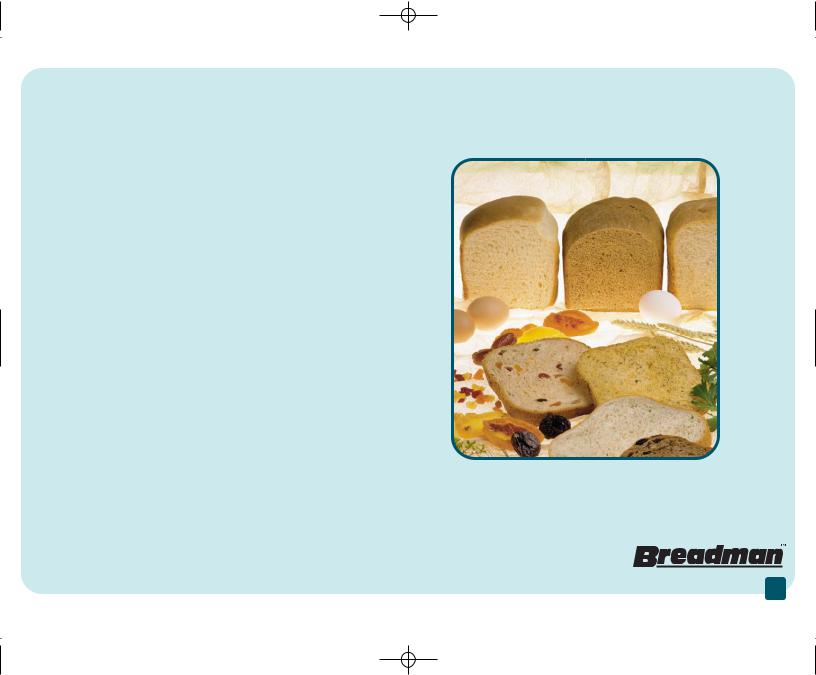
R888_Cookbook_4-4-03 4/4/03 8:09 PM Page 9
Bread
Bread...As Easy As 1-2-3
1.Add ingredients to the bread pan in the order listed. Place the bread pan in the bread machine.
2.Close the lid. Select the desired setting. PressSTART.
3.When the program is complete, remove bread bread pan from the bread machine using oven mitts. Invert and shake to remove the loaf. Allow loaf to cool, standing upright on a wire rack before slicing.
We suggest starting your bread making with the White Bread recipe on page 10. Follow each step carefully. These steps have been written to eliminate the most common errors in bread machine baking and may be helpful for any recipe.
9.
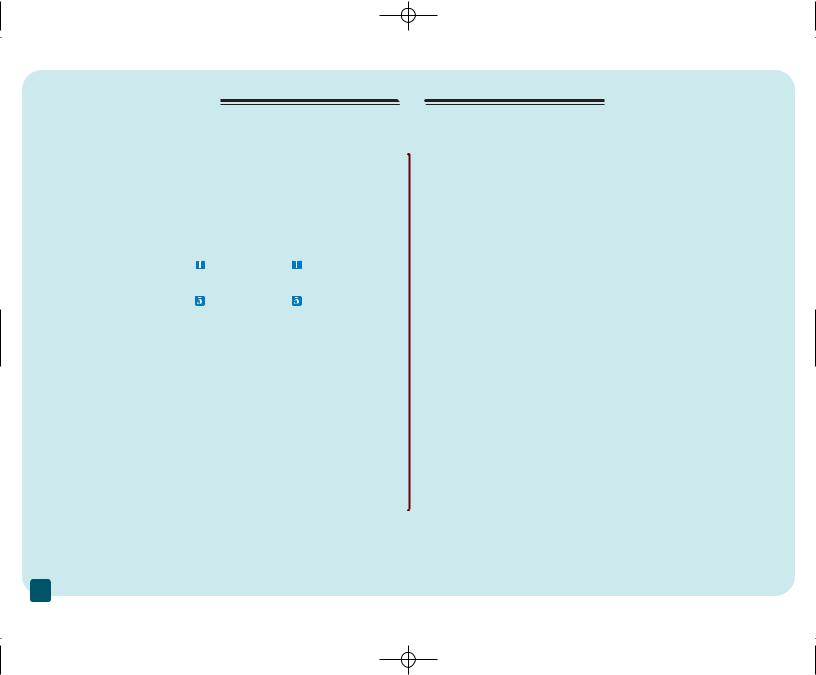
R888_Cookbook_4-4-03 4/4/03 8:09 PM Page 10
White Bread
Size of Loaf |
1 pound |
2 pounds |
water 80°F/27°C |
p cup + 1 TBL |
12 cups |
oil |
1 TBL |
2 TBL |
sugar |
12 TBL |
2 TBL |
salt |
1 tsp |
2 tsp |
dry milk |
1 TBL |
2 TBL |
bread flour |
24 cups |
4 cups |
active dry yeast |
14 tsp |
12 tsp |
Program |
|
|
Quick•Rise™ yeast |
2 tsp |
22 tsp |
Insta Program |
|
|
Basic Recipe & Method
1.Remove the bread pan from the bread maker. Attach the kneading blade onto the shaft. Make sure all ingredients, except water, are at room temperature.
2.Use a liquid measuring cup to measure the water (80°F/27°C) and pour into the bread pan.
3.Use a measuring spoon to measure the oil and add to the bread pan.
4.Use a measuring spoon to measure the sugar, salt and dry milk; level off with the straight edge of a knife and add to the bread pan.
5.Lightly spoon bread flour into a dry measuring cup, level off with the straight edge of a knife and add to the bread pan.
6.Carefully measure yeast with a measuring spoon; level off with the straight edge of a knife and add to the bread pan. If using delay timer, make sure yeast is on top of bread flour, away from liquids.
10.
7.Place the pan into the bread machine. Close the lid.
8.SelectBASIC PROGRAM, press BAKINGto select crust color desired, and set timer to delay, or press START for immediate start.
9.At the end of the first knead process, check the dough ball. It should be slightly tacky to the touch. At this time, push down any dough or flour that may be on the sides of the pan.
10.Use oven mitts to carefully remove the bread pan at end of bake process or at any time during the warm process.
CAUTION: The oven cavity, bread pan, kneading blade and bread will be very hot. Use oven mitts.
11.Turn bread pan upside down and shake several times to release the bread. If the bread loaf does not remove from pan easily, allow it to set on a heat resistant surface. Do not use metal utensils inside the bread pan or machine. Remove the kneading blade and allow loaf to cool standing upright on wire rack approximately 20 minutes before cutting.
12.When the bread has completely cooled, approximately 1 hour, store in an air tight container.
13.Unplug bread maker and allow to cool completely before cleaning. Clean bread pan after each useDo. not immerse the bread
pan in water (See cleaning instructions.) Clean inside of bread maker after each use.
(Note: The Basic Recipe & Method for the White Bread recipe are similar for all breads listed in the cookbook.)
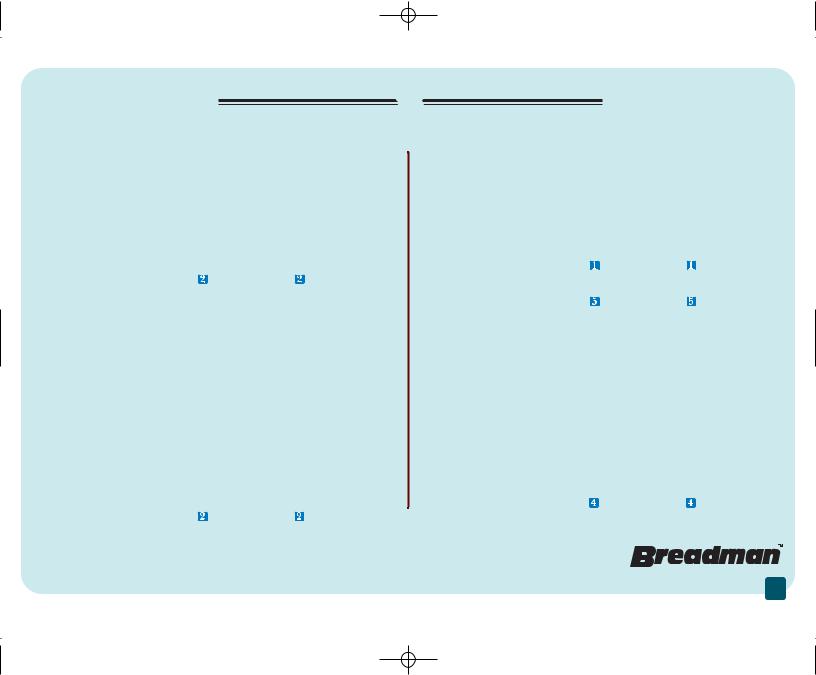
R888_Cookbook_4-4-03 4/4/03 8:09 PM Page 11
Cinnamon Raisin Bread |
|
|
|
Fat Free White Bread |
|
||
Size of Loaf |
1 pound |
|
2 pounds |
Size of Loaf |
1 pound |
2 pounds |
|
water 80°F/27°C |
p cup |
|
12 cup + 1 TBL |
water 80°F/27°C |
p cup + 1 TBL |
12 cups |
|
oil |
1 TBL |
|
2 TBL |
applesauce* |
1 TBL |
2 TBL |
|
sugar |
21 TBL |
2 |
2 TBL |
sugar |
12 TBL |
2 TBL |
|
salt |
1 tsp |
1 |
tsp |
salt |
1 tsp |
2 tsp |
|
dry milk |
1 TBL |
|
2 TBL |
dry milk |
1 TBL |
2 TBL |
|
oatmeal, quick or regular |
2 cup |
4 |
1 cup |
bread flour |
24 cups |
4 cups |
|
bread flour |
2 cups |
3 |
cups |
active dry yeast |
14 tsp |
12 tsp |
|
active dry yeast |
1p tsp |
|
2 tsp |
Program |
|
|
|
Program |
|
|
|
|
Quick•Rise™ yeast |
2 tsp |
22 tsp |
|
|
|
|
|
|||
Add at beep |
|
|
|
|
Insta Program |
|
|
p tsp |
|
41 |
|
|
|
|
|
cinnamon |
|
tsp |
*Any variety |
|
|
||
raisins |
3 cup |
|
l cup |
(Note: Substituting applesauce for oil in other recipes may not produce good |
|||
walnuts |
3 cup |
|
l cup |
results.) |
|
|
|
Dried Fruit Bread |
|
|
|
|
French Bread |
|
|
|
Size of Loaf |
1 pound |
|
2 pounds |
Size of Loaf |
1 pound |
2 pounds |
||
water 80°F/27°C |
p cup |
|
31 |
cups |
water 80°F/27°C |
p cup + 2 TBL |
13 cup + 1 TBL |
|
oil |
1 TBL |
2 |
2 TBL |
oil |
2 TBL |
2 TBL |
||
salt |
1 tsp |
1 |
tsp |
sugar |
1 TBL |
1 TBL + 1 tsp |
||
brown sugar |
12 TBL |
|
4 cup |
salt |
1 tsp |
2 tsp |
||
dry milk |
1 TBL |
|
3 |
TBL |
bread flour |
24 cups |
4 cups |
|
bread flour |
24 cups |
|
4 cups |
active dry yeast |
14 tsp |
12 tsp |
||
active dry yeast |
1p tsp |
|
1 |
TBL |
Program |
|
|
|
Program |
|
|
|
|
|
|
|
|
Add at beep |
3 cup |
|
|
|
|
|
|
|
dried fruit bits |
|
1 cup |
|
|
|
|
||
nutmeg |
1 tsp |
2 |
1 |
tsp |
|
|
|
|
|
|
|
|
|||||
11.
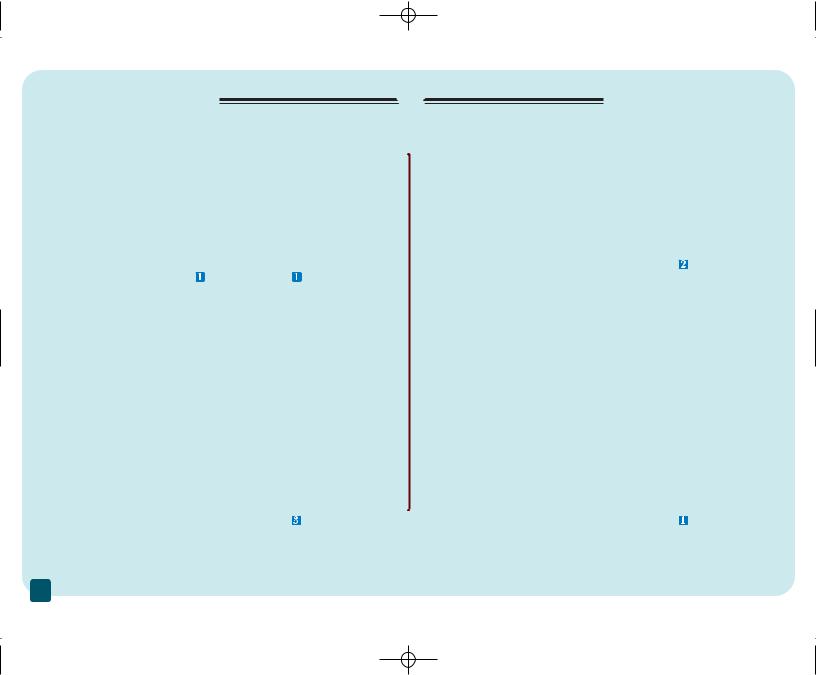
R888_Cookbook_4-4-03 4/4/03 8:09 PM Page 12
Buttermilk Bread
Size of Loaf |
11/2 pounds |
2 pounds |
cultured buttermilk |
1 cup |
12 cups |
80°F/27°C |
|
|
oil |
3 TBL |
4 cup |
honey |
3 TBL |
4 cup |
salt |
21 tsp |
2 tsp |
baking soda |
4 tsp |
2 tsp |
bread flour |
34 cups |
44 cups |
active dry yeast |
12 tsp |
1p tsp |
Program |
|
|
Pumpernickel Bread
Size of Loaf |
2 pounds |
water 80°F/27°C |
1l cups |
oil |
2 TBL |
molasses |
4 cup |
salt |
2 tsp |
dry milk |
2 TBL |
cocoa powder |
4 cup |
instant coffee granules |
2 tsp |
caraway seeds |
2 TBL |
rye flour |
12 cups |
whole wheat flour |
2 cup |
bread flour |
2p cups |
active dry yeast |
24 tsp |
Program |
|
12.
Peanut Butter Honey Bread
Size of Loaf |
2 pounds |
water 80°F/27°C |
13 cups |
peanut butter, any style |
p cup |
honey |
3 cup |
salt |
2 1 tsp |
dry milk |
3 TBL |
bread flour |
4 cups |
active dry yeast |
2 3/4 tsp |
Program |
|
Seed Bread
Size of Loaf |
2 pounds |
water 80°F/27°C |
1 cup + 2 TBL |
oil |
1 TBL |
honey |
3 TBL |
salt |
1 tsp |
bread flour |
3 cups |
oatmeal, quick |
3 cup |
or regular gluten |
4 tsp |
sunflower seeds |
4 cup |
sesame seeds |
2 TBL |
poppy seeds |
2 TBL |
anise seeds |
2 tsp |
active dry yeast |
24 tsp |
Program |
|
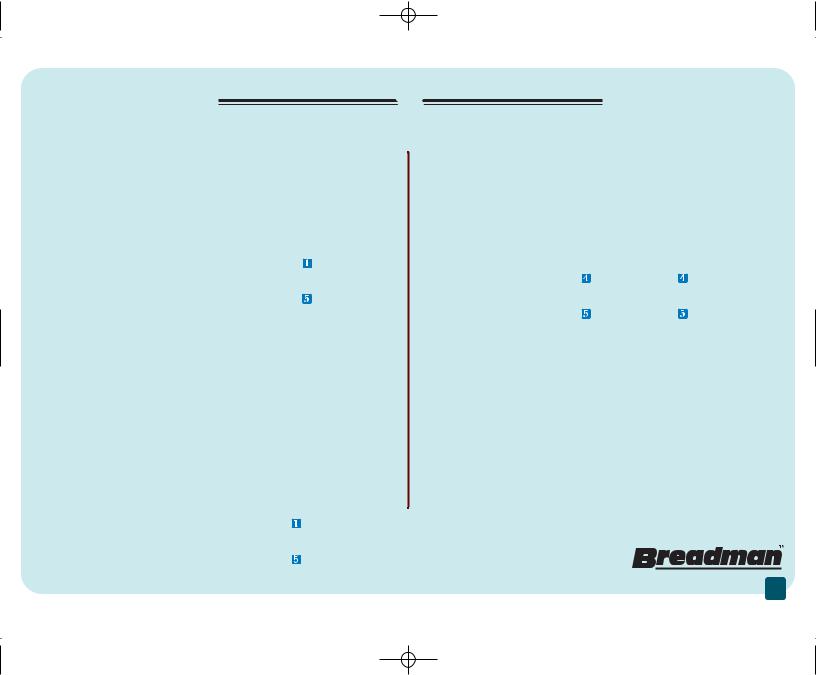
R888_Cookbook_4-4-03 4/4/03 8:09 PM Page 13
Pesto Bread
Size of Loaf |
2 pounds |
water 80°F/27°C |
13 cups |
prepared pesto 80°F/27°C |
3 cup |
salt |
12 tsp |
sugar |
2 TBL |
whole wheat flour |
14 cups |
bread flour |
3 cups |
active dry yeast |
2 tsp |
Program |
|
Quick•Rise™ yeast |
1 TBL |
Insta Program |
|
Dill Bread
Size of Loaf |
|
2 pounds |
|
water 80°F/27°C |
|
p cup |
|
cottage cheese |
|
1 cup |
|
oil |
|
2 TBL |
|
sugar |
|
3 TBL |
|
salt |
2 |
1 |
tsp |
dry milk |
|
2 TBL |
|
bread flour |
4 |
4 |
cups |
dried dill weed |
|
1 TBL |
|
dried minced onion |
|
1 TBL |
|
active dry yeast |
|
12 tsp |
|
Program |
|
|
|
Quick•Rise™ yeast |
|
22 tsp |
|
Insta Program |
|
|
|
Italian Herb Bread
Size of Loaf |
1 pound |
2 pounds |
water 80°F/27°C |
p cup + 2 TBL |
13 cups |
oil |
4 tsp |
3 TBL |
sugar |
1 TBL |
2 TBL |
salt |
1 tsp |
1 tsp |
dry milk |
1 TBL |
2 TBL |
bread flour |
42 cups |
43 cups |
dried Italian seasoning |
1 tsp |
4 tsp |
active dry yeast |
14 tsp |
21 tsp |
Program |
|
|
Quick•Rise™ yeast |
2 tsp |
2p tsp |
Insta Program |
|
|
13.
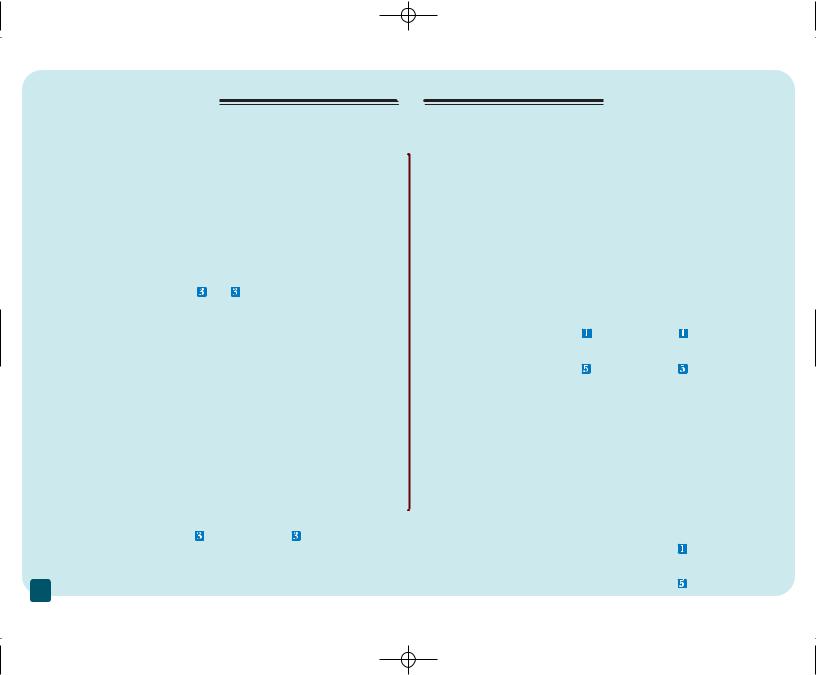
R888_Cookbook_4-4-03 4/4/03 8:09 PM Page 14
Hearty Nut Bread
Size of Loaf |
1 pound |
2 pounds |
|
water 80°F/27°C |
1 cup |
13 cups |
|
oil |
2 tsp |
1 |
TBL |
honey |
3 TBL |
3 cup |
|
salt |
1 tsp |
2 tsp |
|
dry milk |
1 TBL |
2 TBL |
|
whole wheat flour |
1 cup |
2 cups |
|
bread flour |
13 cups |
42 |
cups |
walnuts |
2 cup |
l cup |
|
active dry yeast |
1p tsp |
2 |
tsp |
Program
Whole Wheat Bread
Size of Loaf |
1 pound |
2 pounds |
||
water 80°F/27°C |
p cups + 3 TBL |
41 |
cups + 2 TBL |
|
oil |
2 TBL |
3 TBL |
||
salt |
21 |
tsp |
42 |
tsp |
brown sugar |
4 cup |
4 cup + 2 TBL |
||
dry milk |
2 TBL |
3 TBL |
||
whole wheat flour |
2p cups |
4 cups |
||
active dry yeast |
42 |
tsp |
1 |
TBL |
Program
14.
Jalapeño Bread
Size of Loaf |
1 pound |
2 pounds |
water 80°F/27°C |
2 cup |
1 cup + 1 TBL |
oil |
21 TBL |
3 TBL |
whole kernel corn, |
2 cup |
1 cup |
well drained |
|
|
jalapeño peppers, |
2 TBL |
4 cup |
sliced - well drained |
|
|
sugar |
1 TBL |
2 TBL |
salt |
2 tsp |
21 tsp |
bread flour |
2 cups |
4 cups |
corn meal |
3 cup |
l cup |
cilantro, dried |
1 tsp |
2 TBL |
active dry yeast |
12 tsp |
2 tsp |
Program |
|
|
Quick•Rise™ yeast |
2 tsp |
1 TBL |
Insta Program |
|
|
Potato Bread
Size of Loaf |
2 pounds |
water 80°F/27°C |
14 cups |
oil |
3 TBL |
salt |
2 tsp |
sugar |
3 TBL |
dry milk |
3 TBL |
instant potato flakes |
4 cup |
bread flour |
4 cups |
active dry yeast |
2 tsp |
Program |
|
Quick•Rise™ yeast |
1 TBL |
Insta Program |
|
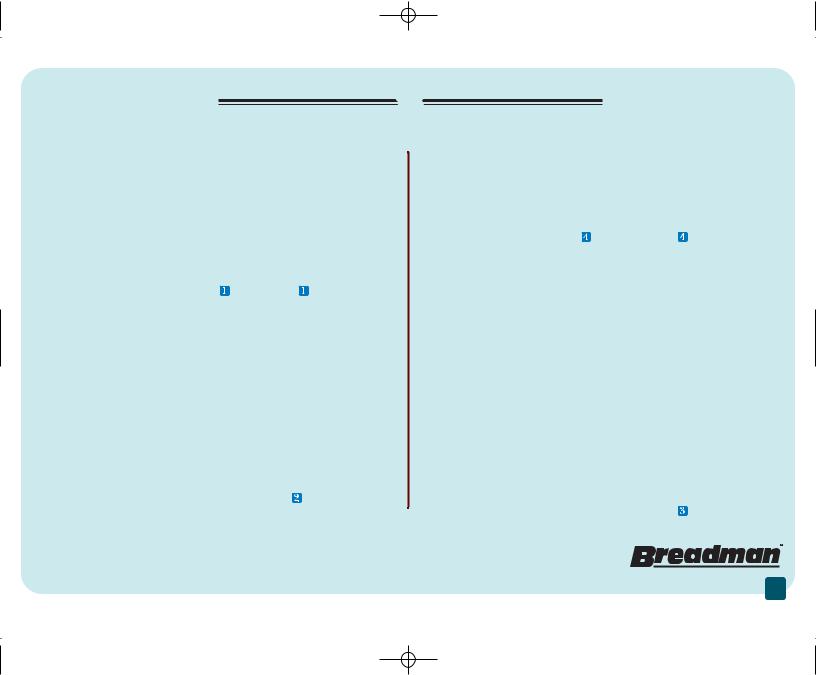
R888_Cookbook_4-4-03 4/4/03 8:09 PM Page 15
Corn Bread
Size of Loaf |
1 pound |
2 pounds |
egg, room temp. + enough |
1 |
2 |
water 80°F/27°C to = |
p cup + 1 TBL |
12 cups |
oil |
2 TBL |
4 cup |
sugar |
2 TBL |
4 cup |
salt |
1 tsp |
2 tsp |
dry milk |
4 cup |
2 cup |
bread flour |
2 cups |
4 cups |
corn meal |
4 cup |
2 cup |
active dry yeast |
12 tsp |
2 tsp |
Program |
|
|
Double Chocolate Bread
Size of Loaf |
2 pounds |
egg, room temp. + enough |
1 |
water 80ºF/27ºC to = |
3/4 cup + 2 TBL |
sour cream 80ºF/27ºC |
2 cup |
oil |
1 TBL |
salt |
12 tsp |
sugar |
4 cup |
bread flour |
4 cups |
cocoa powder |
3 TBL |
active dry yeast |
22 tsp |
Program |
|
Add at beep |
|
semi-sweet chocolate chips |
1 cup |
(Note: This is a very moist, dense bread.) |
|
French Variation Bread
Size of Loaf |
1 pound |
2 pounds |
water 80°F/27°C |
p cup + 2 TBL |
21 cups |
sugar |
1 TBL |
2 TBL |
salt |
1 tsp |
2 tsp |
bread flour |
24 cups |
43 cups |
active dry yeast |
14 tsp |
2 tsp |
Program |
|
|
Caraway Rye Bread
Size of Loaf |
2 pounds |
water 80°F/27°C |
1l cups |
oil |
2 TBL |
molasses |
4 cup |
salt |
2 tsp |
dry milk |
2 TBL |
rye flour |
12 cups |
whole wheat flour |
2 cup |
bread flour |
3 cups |
caraway seeds |
2 TBL |
active dry yeast |
34 tsp |
Program |
|
15.
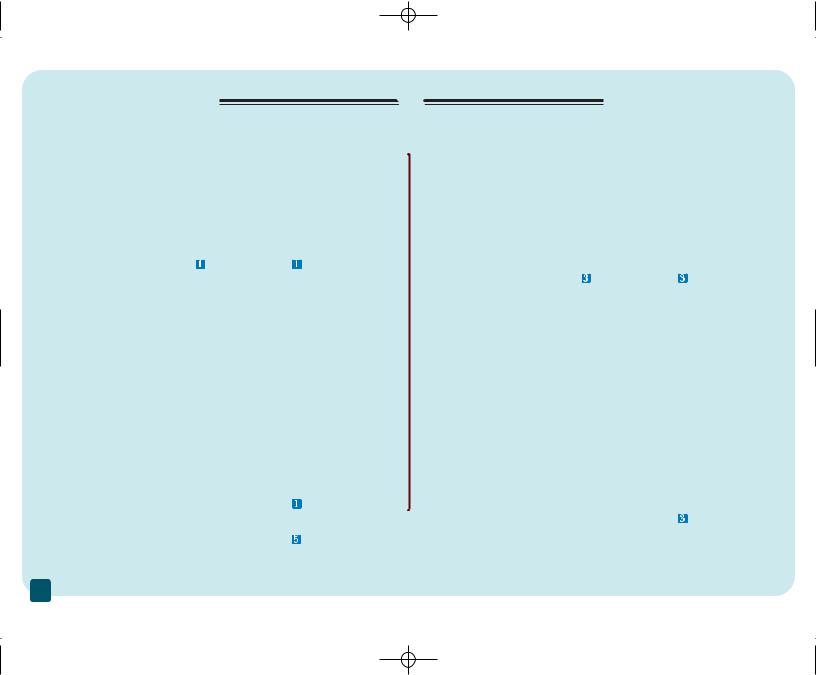
R888_Cookbook_4-4-03 4/4/03 8:09 PM Page 16
Honey Oatmeal Bread
Size of Loaf |
1 pound |
2 |
11/2 pounds |
|
water 80°F/27°C |
1 cup |
1 |
cups |
|
oil |
1 TBL |
2 |
1 |
TBL |
honey |
4 cup |
|
6 TBL |
|
salt |
1 tsp |
2 |
1 |
tsp |
oatmeal, quick or regular |
2 cup |
|
p cup |
|
bread flour |
42 cups |
|
23 |
cups |
active dry yeast |
1 tsp |
|
12 tsp |
|
Program
Sour Cream, Onion & Chives Bread
Size of Loaf |
2 pounds |
egg, room temp. + enough |
1 |
water 80°F/27°C to = |
1 cup |
sour cream 80°F/27°C |
p cup |
oil |
2 TBL |
salt |
24 tsp |
sugar |
2 TBL |
bread flour |
4 cups |
dehydrated onions |
12 TBL |
chives, dried |
2 TBL |
active dry yeast |
24 tsp |
Program |
|
Quick•Rise™ yeast |
34 tsp |
Insta Program |
|
16.
White Wheat Bread
Size of Loaf |
1 pound |
2 pounds |
water 80°F/27°C |
p cup |
12 cups |
oil |
1 TBL |
2 TBL |
salt |
1 tsp |
2 tsp |
brown sugar |
2 TBL |
3 TBL |
dry milk |
1 TBL |
3 TBL |
whole wheat flour |
4 cup |
2 cups |
bread flour |
p1 cups |
2 cups |
active dry yeast |
1 tsp |
2 tsp |
Program |
|
|
Onion Rye Bread
Size of Loaf |
2 pounds |
water 80°F/27°C |
14 cups |
oil |
12 TBL |
molasses |
4 cup |
salt |
12 tsp |
dry milk |
2 TBL |
rye flour |
p cup |
whole wheat flour |
p cup |
bread flour |
22 cups |
dehydrated onions |
12 TBL |
caraway seeds |
4 tsp |
active dry yeast |
22 tsp |
Program |
|
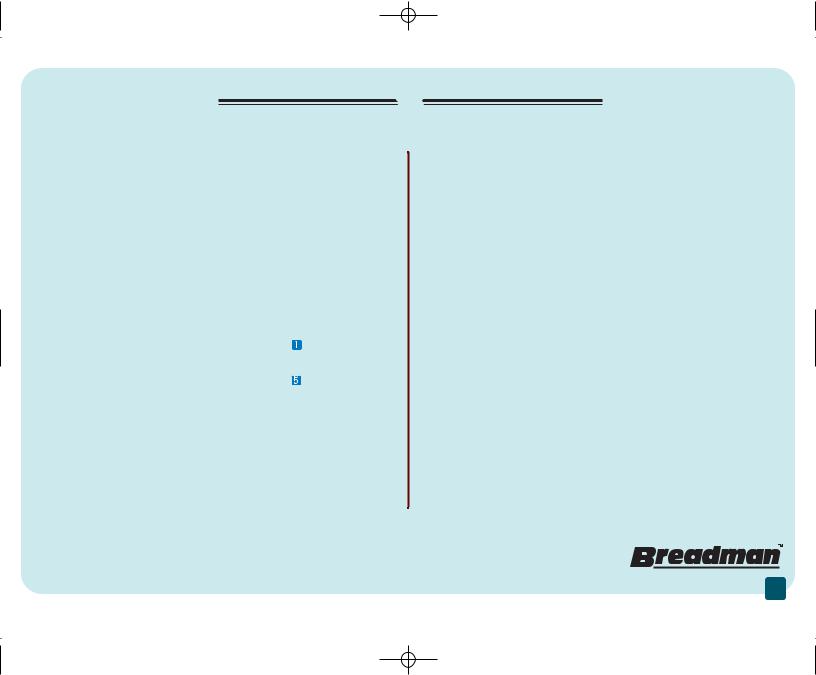
R888_Cookbook_4-4-03 4/4/03 8:09 PM Page 17
Tomato Herb Bread
Size of Loaf |
2 pounds |
water 80°F/27°C |
p cup + 1 TBL |
oil |
2 TBL |
low sodium vegetable juice 80°F/27°C |
2 cup |
salt |
4 1 tsp |
sugar |
2 TBL |
dry milk |
2 TBL |
cilantro leaves, dried |
2 tsp |
oregano leaves, dried |
1 tsp |
garlic powder |
1 tsp |
bread flour |
4 cups |
sun dried tomatoes, snipped, |
2 cup |
unsalted and dried, not packed in oil |
|
active dry yeast |
2 tsp |
Program |
|
Quick•Rise™ yeast |
1 TBL |
Insta Program |
|
17.
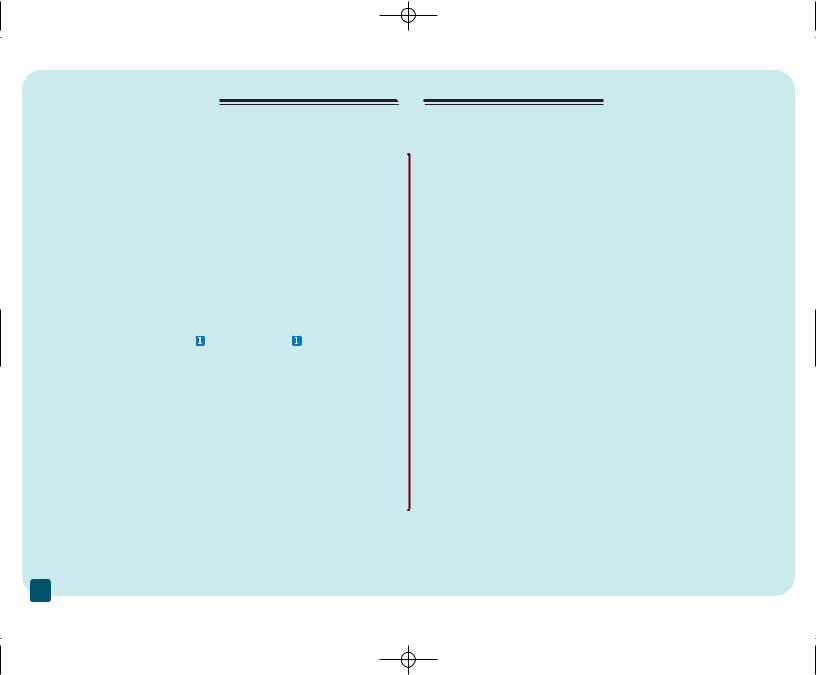
R888_Cookbook_4-4-03 4/4/03 8:09 PM Page 18
Sourdough Starter
active dry yeast |
24 tsp |
water 110°F/43°C |
2 cups |
bread flour |
32 cups |
sugar |
1 TBL |
Sourdough French Bread
Size of Loaf |
1 pound |
2 pounds |
water 80°F/27°C |
2 cup + 1 TBL |
p cup + 2 TBL |
starter* |
p cup |
14 cups |
sugar |
2 tsp |
4 tsp |
salt |
12 tsp |
22 tsp |
bread flour |
24 cups |
4 cups |
active dry yeast |
12 tsp |
1 TBL |
Program |
|
|
*Only use starter recipe above.
18.
Basic Recipe & Method
In a 4 quart glass container, dissolve yeast in water 110°F/43°C; let stand 5 minutes, add flour and sugar. Stir with plastic or wooden spoon until blended. Mixture will be thick; remaining lumps will dissolve during fermentation process. Cover loosely with plastic wrap and let stand in warm place for 5 days, stirring 3 times a day. The starter will “rise and fall” during the fermentation period and become thinner as it stands. A temperature of 80°-85°F/27°-30°C is best for the sour flavor to develop. An ideal place to store starter is on the counter next to your range or refrigerator. When the starter is developed, it is bubbly and may have a yellow liquid layer on top; stir before using. It may be used for baking or placed in the refrigerator to use later, cover loosely.
To use starter, measure the amount specified in the recipe. When refrigerated, let container of starter come to room temperature before measuring
– about 4 hours. If baking in the morning, leave the starter out overnight.
Replenish with 1 cup flour, l cup warm water 110°F/43°C and 1 teaspoon sugar. Stir until blended; some lumps may remain. Cover loosely and let stand in warm place for 10 to 12 hours or overnight. The starter will rise and become bubbly. Stir, then place in refrigerator to store.
Stir in 1 teaspoon sugar to keep it active if the starter is not used every week.

R888_Cookbook_4-4-03 4/4/03 8:09 PM Page 19
Day Old Bread Uses
Breaded Pineapple
chunked pineapple |
1 |
(15-oz) can |
cornstarch |
2 |
TBL |
sugar |
2 cup |
|
butter |
4 cup |
|
white bread, 1 inch cubes |
2 cups |
|
Method
Drain pineapple, reserve juice. Add enough water to juice to equal 1 cup. Mix cornstarch and sugar, add juice and margarine and heat until thick. Pour over pineapple and bread, toss lightly to mix. Bake at 350°F/177°C for 35 minutes.
Bread Pudding
bread, 1 inch cubes |
12 cups |
vanilla cook & serve pudding & pie filling |
1 (3-oz) box |
cinnamon |
1 tsp |
milk, liquid |
2 cups |
Method
Mix all ingredients in a microwave-safe one quart casserole. Cook uncovered in microwave on high for 7 minutes or until boiling – stir occasionally during the last half of cooking. Or, bake in oven at 350°F/177°C for 30 minutes – stir halfway through cooking time. Serve warm or cold.
Crunchy Bread Snacks
bread, sliced2 inch thick |
8 slices |
butter, melted |
4 cup |
dry seasoning mix* |
4 tsp |
*Use any one of the following: dried spaghetti sauce seasoning, dry ranch dressing, Italian herb seasoning, garlic powder or garlic salt. Amounts may be adjusted to your taste.
Method
Melt butter and add seasoning. Place bread on baking sheet and lightly brush with butter mixture. Bake at 350°F/177°C for 10 - 15 minutes or until brown. Allow to cool, breaking into bite size pieces.
19.
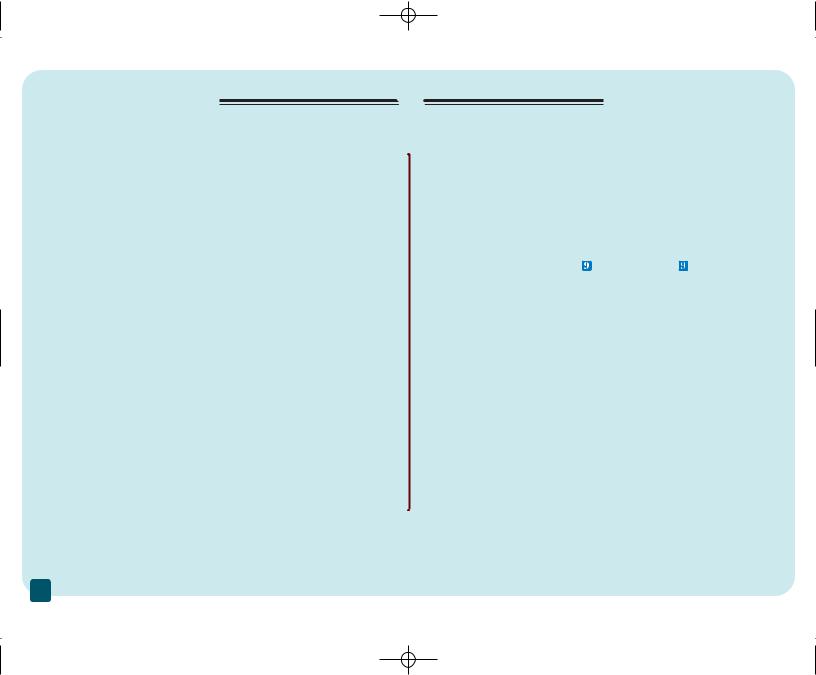
R888_Cookbook_4-4-03 4/4/03 8:09 PM Page 20
Fast Bake™ Breads
The Fast Bake™ program, with hotter rise and bake temperatures, is convenient for baking a hot, fresh loaf of bread in under an hour. The longer bread programs, with lower rise and bake temperatures, will bake a taller, more developed loaf of bread. And remember, you can always use the delay feature for the longer programs.
As a result of the increased temperatures during the rise and bake process, the loaf of bread produced from this program may have a dark, crisp crust with a split on the top side of the loaf.
We suggest starting your Fast Bake™ bread baking with this White Bread Recipe. Follow each step carefully, noticing the water temperatures must be 110°-115°F/43°-46°C and that Quick•Rise™, Rapid Rise™, Bread Machine or Instant Active Dry yeast must be used.
20.
White Bread
Size of Loaf |
11/2 pound |
2 pounds |
110°-115°F/43°-46°C |
14 cups |
21 cups + 3 TBL |
oil |
22 TBL |
1/4 cup |
sugar |
2 TBL |
3 TBL |
salt |
12 tsp |
2 tsp |
dry milk |
12 TBL |
2 TBL |
bread flour |
3 cups |
4 cups |
Quick•Rise™ yeast |
52 tsp |
6p tsp |
Program |
|
|
Basic Recipe & Method
1.Remove the bread pan from the bread maker. Attach the kneading blade onto the shaft. Have all ingredients ready. Make sure all ingredients, except water, are at room temperature.
2.Use a liquid measuring cup to measure the water 110°-115°F/43°- 46°C and pour into the bread pan.
3.Use a measuring spoon to measure the oil and add to the bread pan.
4.Use a measuring spoon to measure the sugar, salt and dry milk; level off with the straight edge of a knife and add to the bread pan.
5.Lightly spoon bread flour into a dry measuring cup; level off with the straight edge of a knife and add to the bread pan.
6.Carefully measure Quick•Rise™ yeast with a measuring spoon; level off with the straight edge of a knife and add to the bread pan.
7.Place the bread pan into the bread maker. Close the lid.
8.Press the FAST BAKE™ button  and press START.
and press START.
9.At the beep during the kneading process (:53), check the dough ball. It should be sticky to the touch. At this time, push down any dough or flour that may be on the sides of the pan.
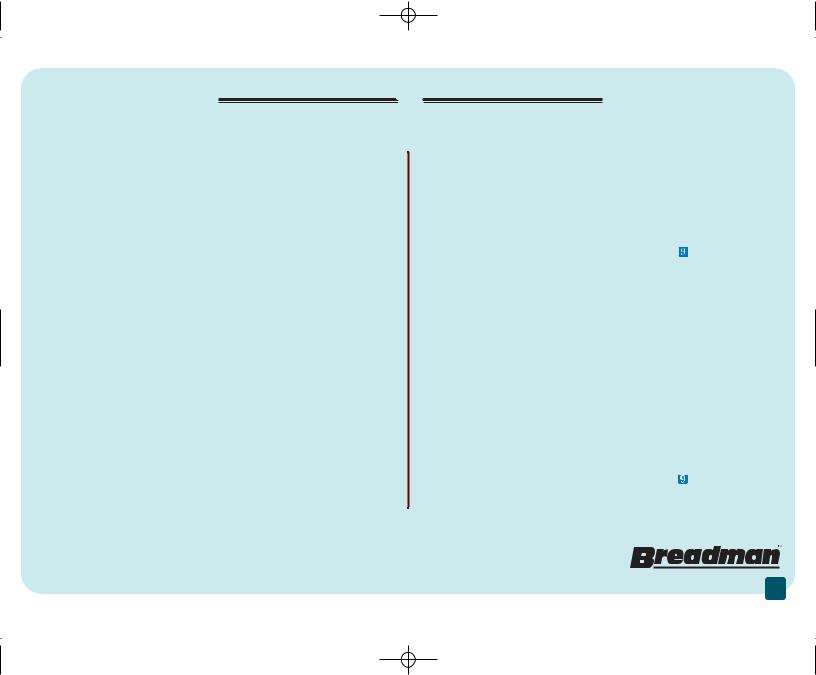
R888_Cookbook_4-4-03 4/4/03 8:09 PM Page 21
10.When the beeper sounds the bread has finished baking.
11.Use oven mitts to carefully remove the bread pan.
CAUTION: The oven cavity, bread pan, kneading blade and bread will be very hot. Use oven mitts.
12.Turn bread pan upside down and shake several times to release the bread. Do not use metal utensils inside the bread pan or bread maker. Remove the kneading blade and allow loaf to cool, standing upright on wire rack approximately 20 minutes before cutting.
13.When the bread has completely cooled, approximately 1 hour, store in an air tight container.
14.Unplug bread maker and allow to cool completely before cleaning. Clean bread pan after each useDo. not immerse the bread
pan in water (See cleaning instructions.) Clean inside of bread maker after each use.
(Note: The Basic Recipe & Method for the Fast Bake™ White Bread recipe are similar for all Fast Bake™ breads listed in the cookbook.)
French Bread
Size of Loaf |
2 pounds |
water 110°-115°F/43° - 46°C |
12 cups + 2 TBL |
oil |
3 TBL |
sugar |
12 TBL |
salt |
12 tsp |
bread flour |
43 cups |
Quick•Rise™ yeast |
6 tsp |
Program |
|
Pepperoni Pizza Bread
Size of Loaf |
2 pounds |
water 110°-115°F/43°-46°C |
12 cups + 2 TBL |
oil |
3 TBL |
pepperoni, thin sliced |
1 cup |
Parmesan cheese, grated |
4 cup |
sugar |
12 TBL |
salt |
12 tsp |
bread flour |
43 cups |
dried pizza seasoning |
1 TBL |
Quick•Rise™ yeast |
6 tsp |
Program |
|
21.

R888_Cookbook_4-4-03 4/4/03 8:09 PM Page 22
Cinnamon Raisin Nut Bread
Size of Loaf |
11/2 pounds |
water 110°-115°F/43°- 46°C |
14 cups + 1 TBL |
oil |
7 tsp |
brown sugar |
32 TBL |
salt |
12 tsp |
dry milk |
12 TBL |
bread flour |
32 cups |
cinnamon |
1 tsp |
raisins |
2 cup |
walnuts |
2 cup |
Quick•Rise™ yeast |
6p tsp |
Program |
|
Honey Granola Bread
Size of Loaf |
2 pounds |
water 110°-115°F/43°-46°C |
12 cups + 1 TBL |
oil |
6 TBL |
honey |
22 TBL |
salt |
2 tsp |
dry milk |
3 TBL |
bread flour |
44 cups |
granola cereal |
1 cup |
Quick•Rise™ yeast |
6p tsp |
Program |
|
22.
Potato Bread
Size of Loaf |
2 pounds |
water 110°-115°F/43°-46°C |
14 cups + 3 TBL |
oil |
3 TBL |
sugar |
2 TBL |
salt |
2 tsp |
dry milk |
4 cup |
white pepper |
4 tsp |
instant potato buds |
2 cup |
green onion tops, chopped |
2 TBL |
bread flour |
4 cups |
Quick•Rise™ yeast |
6p tsp |
Program |
|
Italian Bread
Size of Loaf |
2 pounds |
water 110°-115°F/43°-46°C |
12 cups + 1 TBL |
oil |
2 TBL |
sugar |
4 cup |
salt |
2 tsp |
dry milk |
2 TBL |
dried Italian seasoning |
1 TBL |
bread flour |
4 cups |
Quick•Rise™ yeast |
6p tsp |
Program |
|
